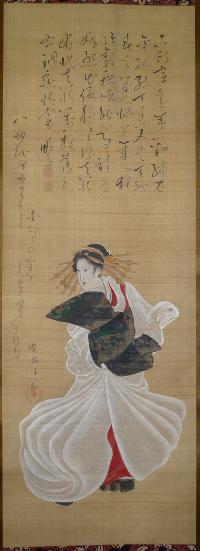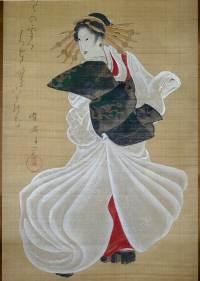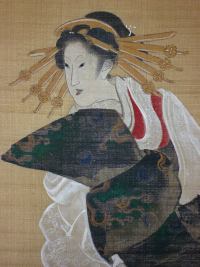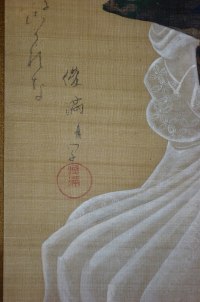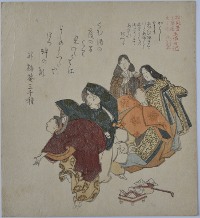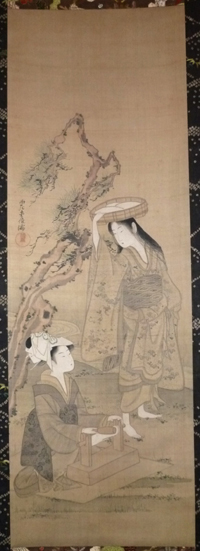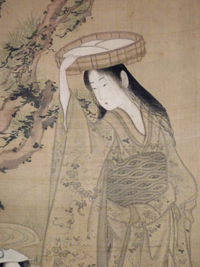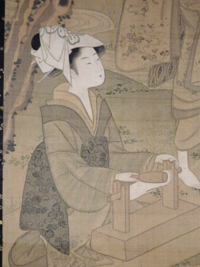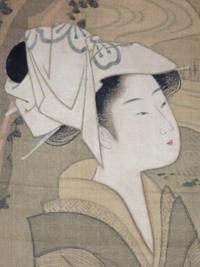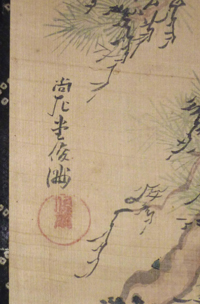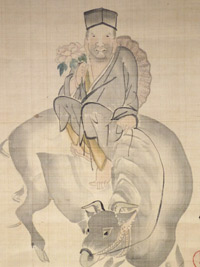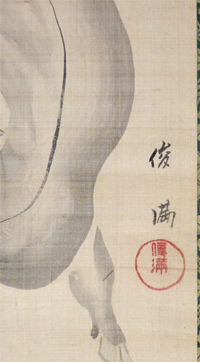Kubo SHUMMAN (1757-1820) and Kameda BOSAI (1752-1826)
Click here to view image full size.
An original painting showing a parading oiran on the first day of the eighth month, Hassaku (hachigatsu sakuhi). It was common on this day to wear a white kimono. This festival still takes place in the Gion quarters of Kyoto. The calligraphy, above, is by Bosai (Hosai), an amateur artist and noted scholar and writer. Full colour on silk, 35.25 x 12.5 in; 89.5 x 31.7 cms. In good condition. Signed Shumman painted by himself with Shumman seal.
Status: Sold
Kubo SHUMMAN (1757-1820)
Click here to view image full size.
A surimono showing court figures dancing from a series: Shofudai Hisakataya Bunbunsha Tosa Nikki, “The Tosa Diary for the Shofudai, Hisakataya and Bunbunsha Poetry Groups.” Issued late 1810s. For another from this series see: Jewels Of Japanese Printmaking: Surimono Of The Bunka-Bunsei Era 1804-1830, Joan B. Mirviss, Ota Memorial Museum of Art, 2000, no. 85, p. 131. Rare: Possibly the only known impression.
Fine impression. Very good colour. Lightly backed, otherwise very good condition. Artist’s seal Sho Shumman.
Status: Sold
Kubo SHUMMAN (1757-1820)
Click here to view image full size.
A fine painting showing a seated girl fulling cloth ( a process of beating which eliminated the dirt and other impurities ) with another standing beauty holding beaten cloth in a wooden tray on her head. This scene represents Mishima, or Toi, Province of Settsu. One of the Six Crystal ( Tama ) Rivers. ( Toi is the alternative name of the river and the word for beating cloth. ) This was probably Shumman’s most celebrated subject. He produced a set of six prints on this theme published by Fushimiya Zenroku, c 1787. One of the most beautiful 18th century sets, and together with a night triptych showing people returning from a poetry reading, is considered his masterpiece. The prints and the known paintings of this subject use the benigirai style, “red avoiding” pioneered by Shumman, Eishi and Shuncho. Shumman, a man of great sophistication, designed only a few prints before concentrating on surimono and printing and issuing some of the finest in this format. ( See The Japanese Print A New Approach, J. Hillier, pp. 102-104: “Probably no artist except Choki has achieved so high a reputation on such a small number of prints.” ) He also excelled at painting, book illustration and light verse. Painted on silk in tones of sumi, very light green, gofun and a small touch of red on the girls’ lips. Image size: 36 x 12 in; 91.5 x 30.5 cms. Other versions of this subject are in the BM ( 1922.2-13.01 ) and the Freer Gallery of Art ( FI903.62 ), gift of Charles Freer. Painted c early 1790s. Slight loss of gofun and very minor spotting, but otherwise in very good condition. Interesting old mount. Exhibited in 1995 at Shunsen Museum in Nanamashi prefecture, Nikushitsu ukiyoe meisaku ten, hosted by Mr Keizaburou Yamaguchi, p. 40, no, 37. Painting guaranteed by Mr Narazaki, the box being signed and dated 1988 by him. Signed Shosado Shumman, with circular Shumman seal.
Status: Sold
Kubo SHUMMAN (1757-1820)
Click here to view image full size.
A fine painter and renowned for his surimono, and for supervising the design and carving of them for fellow poets. Produced some refined prints and contributed to kyoka anthologies. Changed the character with which he wrote “Shun” of Shunman from”Spring” to “Excel” in 1782. Shows a Botangesyohaku ( poet ) holding a peony and riding an ox. The kyoka poem above is by Ota Nampo ( 1749-1823 ), a leading light of popular literature who often collaborated with Shumman. Sumi and light colour on silk. 36 x 12 in; 91.5 x 30.5 cms. Old mount and box. In very good condition. Signed and sealed Shumman.
Status: Sold
